This coming year, WDTD will offer four tracks of the Warning Operations Course (Human Factors, Severe, Flash Flood, and Winter) as part of seasonal readiness training.
Warning Decision Training Division
Office of Chief Learning Officer
Seasonal Readiness is a concept analogous to spring training in baseball: train as you play. It is available for NWS Meteorologists with warning responsibilities. The idea is that WDTD releases lesson material in time for most local offices and/or individual forecasters to prepare training plans in advance of upcoming severe, flash flood, and winter seasons. Within this framework, local WFO SOOs and training facilitators have the flexibility to “peruse” the available lessons and create curricula tailored to their local needs and training gaps.
WDTD has several tools to support local offices, including brief online surveys about lesson content in order to determine which lessons may be worth assigning, as well as regular LMS reports for situational awareness. Note that each WOC track (as listed below) is still available to take in its entirety to receive FY26 WOC certificates of completion. The following sections will outline the Seasonal Readiness training tools for each track, along with a section about how the NWS Virtual Lab (VLab) will aid in hosting many of the tools and references.
Release Date: Human Factors (Late June, 2026), Severe Track (Late January 2026), Flash Flood Track (Early December 2026), and Winter Track (September 25th, 2025).
* The FY26 Seasonal Readiness training tools for each of the WOC tracks will be released on the aforementioned dates above. Keep in mind that individual offices have the flexibility to plan and execute their personalized training plans closer to the start of their climatological convective or rainy seasons. For example, offices in the Northern Plains can execute their severe weather Seasonal Readiness plans later in the Spring, ahead of the usually active summer months.
For each track, we have created a catalog of the available lessons from the latest WOC release, powered by Google Sheets. Each spreadsheet contains information about each of the available modules, the lesson’s learning objectives, length of the online module, and the last time the lesson module was updated. This aid is meant to provide transparency about what you can expect from each lesson. SOOs/DOHs can use this to determine office-wide needs, or as a “conversation starter” with individuals. Overviews of each WOC track (Severe, Human Factors, Flash Flood, and Winter) are detailed in the next section.
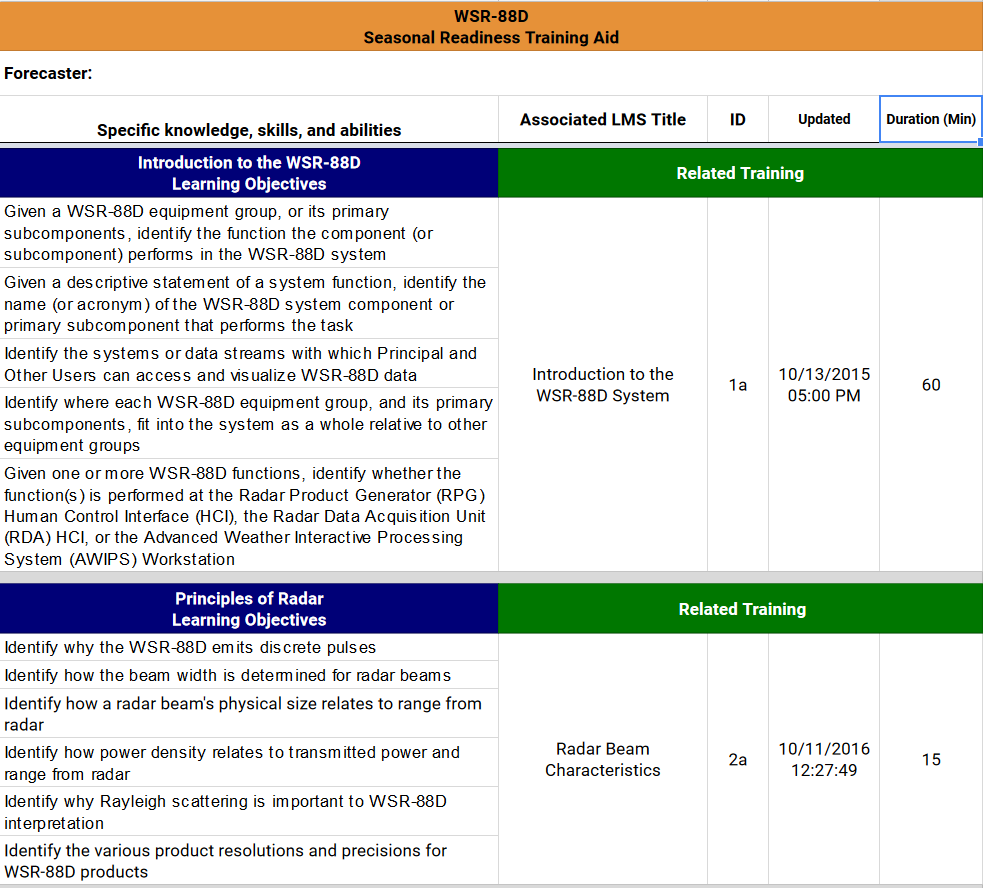 Catalogue for WSR-88D |
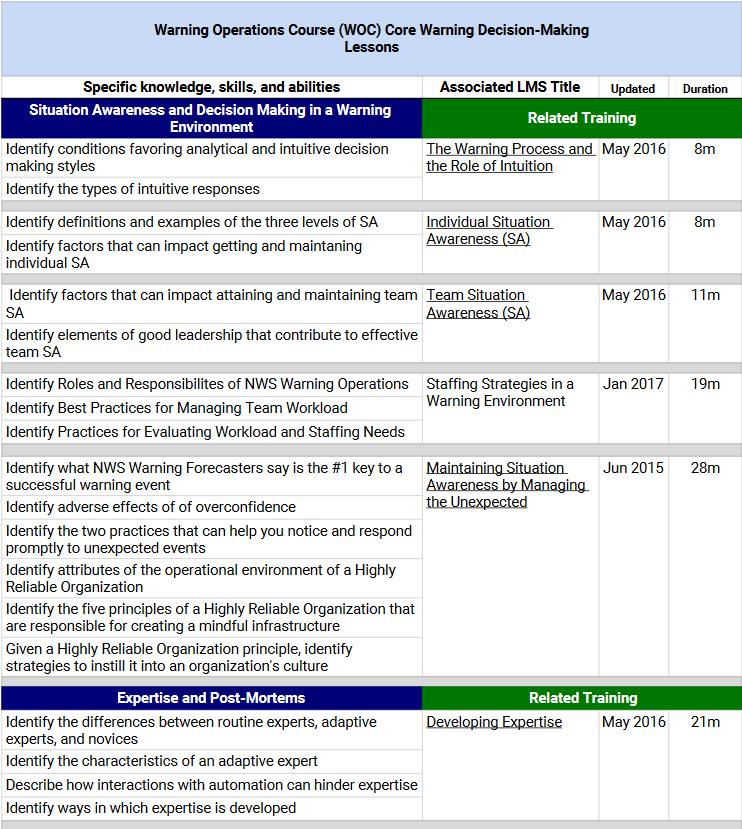 Catalog for Human Factors |
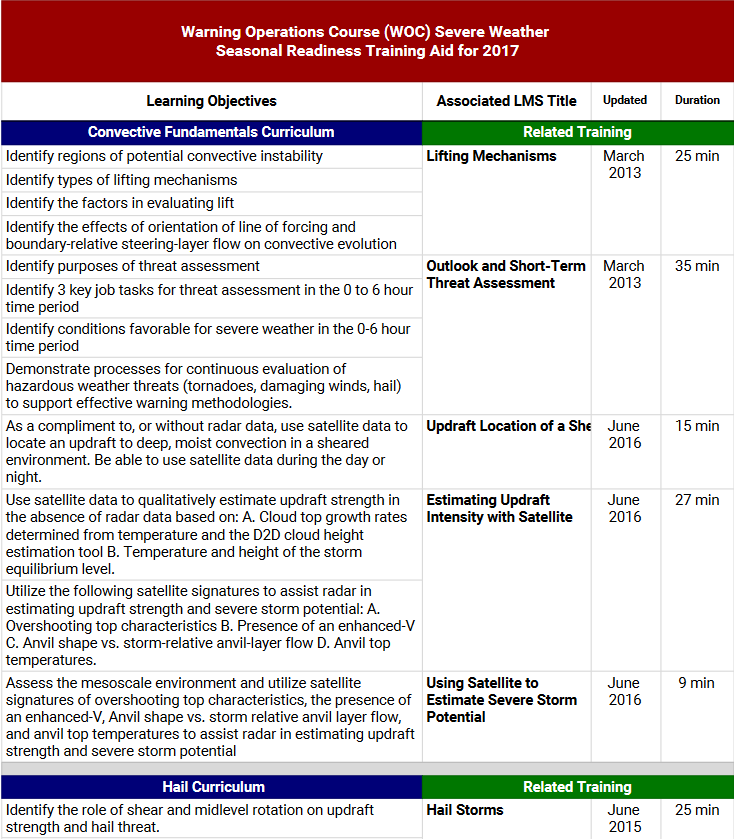 Catalog for Severe |
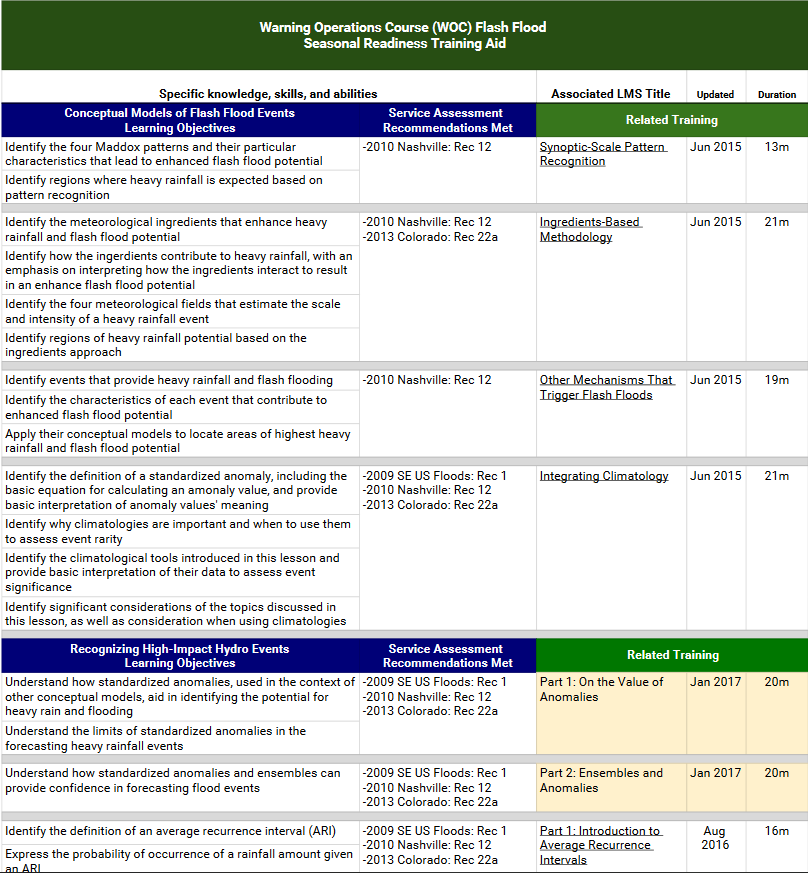 Catalog for Flash Flooding Catalog for Flash Flooding |
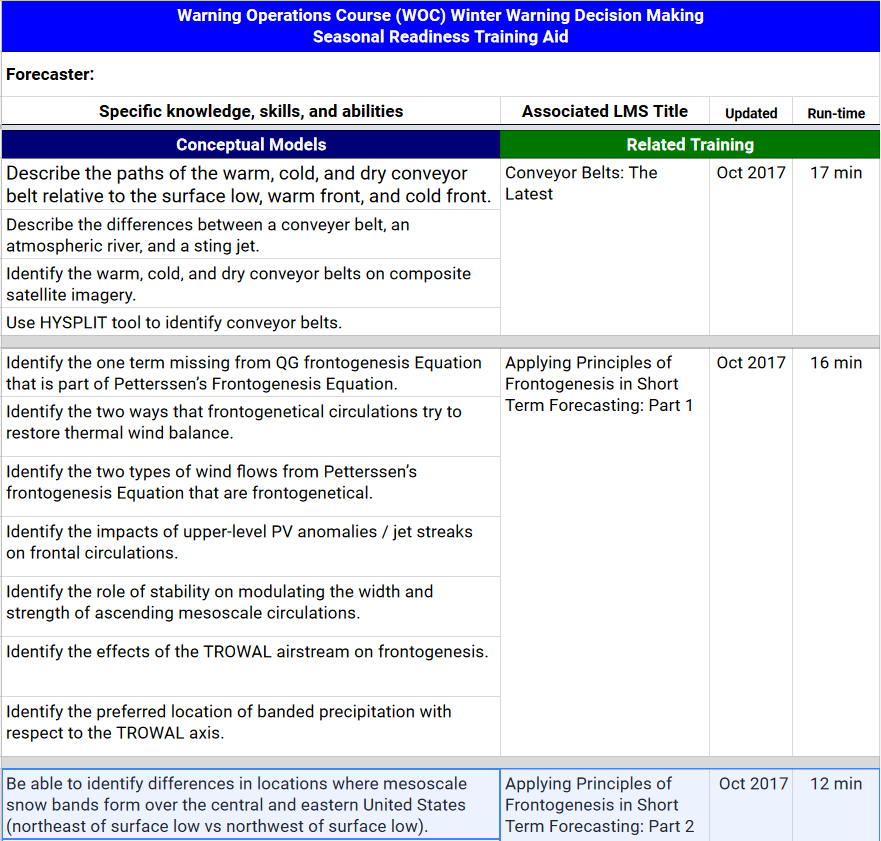 Catalog for Winter |
WDTD will provide regular (e.g. monthly) LMS reports for offices who wish to participate in Seasonal Readiness. This allows training officers to keep track of forecaster completions. It is mainly a situational awareness tool.
The Radar & Applications Course (RAC) trains National Weather Service (NWS) meteorologist and hydrologist forecasters in the use of the WSR-88D radar to support forecasting and warning decisions. This four-month course uses a blended format that includes online modules, instructor-led webinars, applied drills, and a one-week in-residence workshop held in Norman, Oklahoma. Topics include the WSR-88D system, radar principles, base and derived products, Multi-Radar/Multi-Sensor (MRMS) products, convective storm structure and evolution, flash floods, warning fundamentals, and the human role in the warning process.
WOC Human Factors Seasonal Readiness topics include situation awareness, office strategies, and public response. These lessons also include addressing your health during warning operations, methods for constructing an effective warning, eliciting the proper public response, and understanding the way NWS warnings will be used, and reacted to by the general public. Forecasters will also complete a graded assignment covering how to conduct and evaluate Root Cause Analyses, which focus on fact finding investigations for improving processes and office operations.
Seasonal Readiness gives local WFO SOOs and training facilitators a template for potential training plans for their staff but also the flexibility to determine their own plans. If an office already performs a local “pre-season” training regime through either a local workshop/seminar for the staff, a drill with questions about operational protocol, convective weather exercises through a local WES (Weather Event Simulator) case, or a combination of these, Seasonal Readiness is designed to supplement this effort. The training modules, exercises, and other training delivery through WOC Severe can be taken individually or in any combination, meeting more targeted needs for each office and operation.
NOTE: The content from this track is designed for NWS meteorologists that have completed the Radar and Applications Course (RAC; 2016-present), Distance Learning Operations Course (DLOC; 1998-2015), or WSR-88D Operations Course (1990-1997). The lessons build on fundamental understanding of the WSR-88D products (including MRMS) and mastery of certain convective-related processes in the lessons’ learning objectives. NWS meteorologists who wish to complete a “refresher” of these radar products, as they relate to severe convection, should consider refreshing any RAC modules that may boost their learning, then complete the WOC Severe Weather track after that.
Topics covered by the online lessons include conceptual models of flash flood events, how to use a variety of flash flood tools, and best practices related to flash flood warning decision making. Forecasters can apply Flash Flood concepts in an operational context in a two-part simulation. The first application focuses on applying meteorological conceptual models and ingredients for a short-term forecast. The second application focuses on the warning decision-making process and conveying the threat in Flash Flood Warning products in a displaced real-time (DRT) environment. Forecasters will use a variety of tools and products to perform the tasks, including GFE, WarnGen, FFMP, MRMS, and FLASH. To request this simulation, please contact the WDTD WOC Flash Flood Team.
The Winter Weather Warning Seasonal Readiness Training (SRT) for FY23 is based upon the latest Winter Weather Warning Professional Development Series (PDS) developed by the NWS operational community. The WDTD has been resourced to provide your forecasters with the warning-related competencies needed for effective winter weather warnings.
Thanks to a group of subject matter experts in the NWS field, academia, NWS Headquarters, and the Cooperative Office for Meteorological Education and Training (COMET), this course contains lessons in seven different topic areas,
The Winter Weather SRT contains assessments you can use to assess your staff’s knowledge of the learning objectives within the WOC Winter course. Then, the SRT helps link the appropriate lessons in the CLC to address any gaps in knowledge that you discover. The SRT provides the following for the SOO:
Q: I am concerned about the length of this course. One of the reasons I and my colleagues haven’t taken AWOC in several years is that it is just too long, too many elements that are tough to match up with my schedule of rotating shifts and priorities of inclement weather over training. Why would Seasonal Readiness change this opinion?
A: Seasonal Readiness is NOT a course; it is a method to take a smaller, more targeted subset of modules from each of the WOC tracks. Additionally, you determine your training along with your local training officer. Using the training aid, you determine what to take based on what is important to you and the enhancement of your skills and knowledge as a NWS Meteorologist with warning responsibilities.
WDTD has heard the overarching sentiment from WFOs about training and how coursework should be more targeted for the changing tasks and duties of the operational staff. Over the past few years, we have worked to shorten the length of our online modules and the WES (Weather Event Simulator) simulations to better fit into the current duty structure and schedule for the average NWS Meteorologist. Seasonal Readiness allows the forecaster and their training officer to target and enhance their meteorological knowledge for areas that they identify, either based upon the forecaster’s skillset and needs or a local/regionally-based curriculum (as opposed to a nationally-derived curriculum).
Q: As the office training facilitator, how do I know which modules I should assign to my operational staff?
A: The tools discussed in the above section are meant to help training officers and/or individual forecasters determine their needs. For instance, in the training aid, we provide the date the lesson was created or last updated. This information could help the SOO determine whether his/her staff is current on certain material. Another example: we provide the performance objectives for every simulation. So a forecaster may see that the latest WES-2 Bridge simulation focuses on how to use Average Recurrence Intervals (ARIs) within AWIPS-2. If he/she thinks that would be good for them to know, they can talk to the SOO to enroll in the simulation.
Q: If my staff are only taking a handful of the total amount of WOC modules, what assures that they are “seasonally ready” when the entire WOC course has not been completed in full?
A: The idea of Seasonal Readiness is that you determine what you need to be “seasonally ready”. WDTD delivers nationally-based training every year to keep up with the latest additions to the operational landscape of meteorology. However, training needs can vary significantly across the country, regions, CWAs, and even smaller geographic scales.
Using common sports analogies may help to drive home this point: in baseball, pitchers and catchers usually do not work on the same drills as infielders, nor do they (or should they) spend as much time practicing their swing in a batting cage as their other teammates who are expected to hit and drive the ball. Conversely, the team’s power hitter is not (and should not) spend much of their training time on a pitcher’s mound, working on an array of pitches. Identify what warning-related training best applies to you and your office to enhance your skills and abilities, but also do not neglect those “rare” (but not unheard of) events. For instance, the Southeastern U.S. can always get a snowstorm, and the Pacific Northwest can always get a mini-tornado outbreak along the coast. The key is to be prepared -- or our term, “seasonally ready”.
Q: How does Seasonal Readiness differ from the Warning Operations Course (WOC)? Aren’t they the same lessons and simulations?
A: Correct, they are the same material. However, Seasonal Readiness allows the flexibility to take a subset of the WOC lessons, in order to best fit your needs. And we have provided specific tools to facilitate this process. But for SOOs who want to enroll their forecasters in an entire WOC track, it is still supported by WDTD as usual. You will only receive a WOC Certificate of Completion for completing all requirements within the WDTD-determined curriculum. You will receive a Seasonal Readiness Certificate of Completion for completing all requirements determined by your training officer.
The concept of “being ready before the season starts” is a familiar one in many professions and facets of life. A “season” most notably refers to the sports world, where athletes prepare for a multi-month season of games or contests with targeted training and preparation to enhance their skills and “knock the rust off” after a lengthy off-season.
Four posters relating to this idea have been created and will be sent to all WFOs. Having them visible in or near the operations area will be a visual reminder to the operational staff about the importance of this concept in tasks and duties.
* Click on each image below to view the larger version.
 |
 |
 |
 |
If you have any questions and comments about anything mentioned or not mentioned on this page and in any of the provided material, we have an e-mail addresss ( ) for all things Seasonal Readiness. This is a new concept or paradigm for our delivered training, so we have no doubt there will be questions that are not covered above. As you give us feedback, we can add it to this page and potentially help others that may have similar sentiments.
) for all things Seasonal Readiness. This is a new concept or paradigm for our delivered training, so we have no doubt there will be questions that are not covered above. As you give us feedback, we can add it to this page and potentially help others that may have similar sentiments.